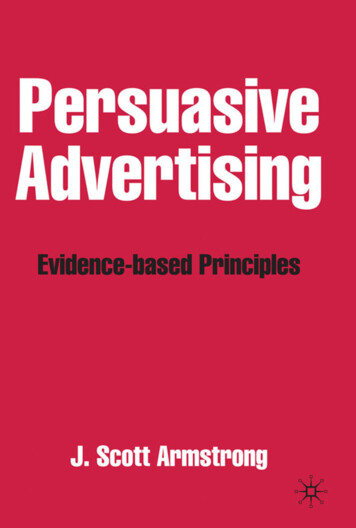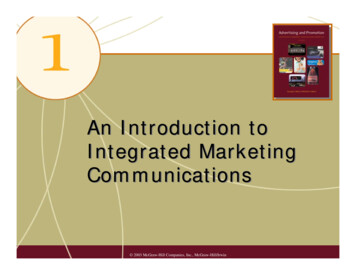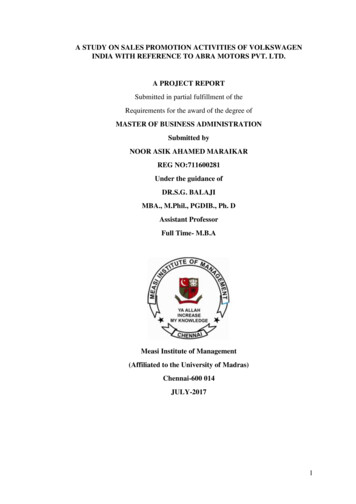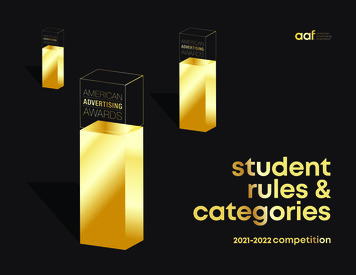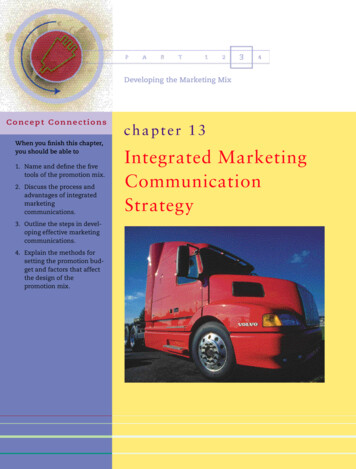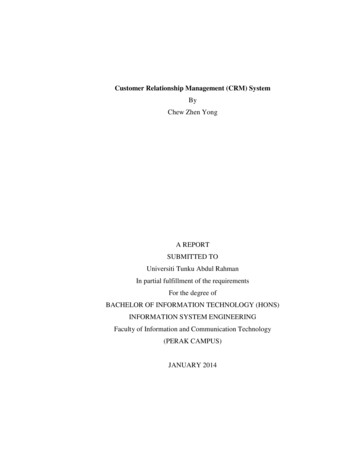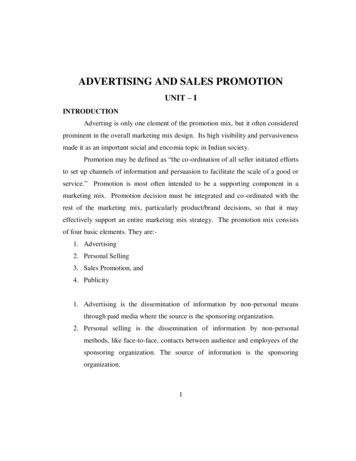
Transcription
ADVERTISING AND SALES PROMOTIONUNIT – IINTRODUCTIONAdverting is only one element of the promotion mix, but it often consideredprominent in the overall marketing mix design. Its high visibility and pervasivenessmade it as an important social and encomia topic in Indian society.Promotion may be defined as “the co-ordination of all seller initiated effortsto set up channels of information and persuasion to facilitate the scale of a good orservice.” Promotion is most often intended to be a supporting component in amarketing mix. Promotion decision must be integrated and co-ordinated with therest of the marketing mix, particularly product/brand decisions, so that it mayeffectively support an entire marketing mix strategy. The promotion mix consistsof four basic elements. They are:1. Advertising2. Personal Selling3. Sales Promotion, and4. Publicity1. Advertising is the dissemination of information by non-personal meansthrough paid media where the source is the sponsoring organization.2. Personal selling is the dissemination of information by non-personalmethods, like face-to-face, contacts between audience and employees of thesponsoring organization. The source of information is the sponsoringorganization.1
3. Sales promotion is the dissemination of information through a wide varietyof activities other than personal selling, advertising and publicity whichstimulate consumer purchasing and dealer effectiveness.4. Publicity is the disseminating of information by personal or non-personalmeans and is not directly paid by the organization and the organization isnot the source.ORIGIN AND DEVELOPMENT OF ADVERTISINGIt has been wrongly assumed that the advertising function is of recent origin.Evidences suggest that the Romans practiced advertising; but the earliest indicationof its use in this country dates back to the Middle Ages, when the use of thesurname indicated a man‟s occupation. The next stage in the evolution ofadvertising was the use of signs as a visual expression of the tradesman‟s functionand a means of locating the source of goods. This method is still in common use.The seller in primitive times relied upon his loud voice to attract attentionand inform consumers of the availability of his services. If there were manycompetitors, he relied upon his own personal magnetism to attract attention to hismerchandise. Often it became necessary for him to resort to persuasion to pinpointthe advantages of his products. Thus, the seller was doing the complete promotionjob himself.Development of retail stores, made the traders to be more concerned aboutattracting business. Informing customers of the availability of supplies was highlyimportant. Some types of outside promotion were necessary. Signs on stores and inprominent places around the city and notices in printed matters were sometimesused.2
When customers were finally attracted to the store and satisfied with theservice at least once, they were still subjected to competitive influences; therefore,the merchant‟s signs and advertisements reminded customers of the continuingavailability of his services. Sometimes traders would talk to present and formercustomers in the streets, or join social organizations in order to have continuingcontacts with present and potential customers.As the markets grew larger and the number of customers increased, theimportance of attracting them also grew. Increasing reliance was placed onadvertising methods of informing about the availability of the products. Theseadvertising methods were more economical in reaching large numbers ofconsumers. While these advertising methods were useful for informing andreminding and reminding, they could not do the whole promotional job. They wereused only to reach each consumer personally. The merchant still used personalpersuasion once the customers were attracted to his store.The invention of hand press increased the potentialities of advertising. ByShakespeare‟s times, posters had made their appearance, and assumed the functionof fostering demand for existing products.Another important event was theemergence of the pamphlet as an advertising medium. The early examples of thesepamphlets disclose their sponsorship by companies want to generate goodwill fortheir activities. The low cost of posters and handbills encouraged a number ofpublishers to experiment with other methods.DEFINITION OF ADVERTISISNGThe word advertising originates from a Latin word advertise, which meansto turn to. The dictionary meaning of the term is “to give public notice or toannounce publicly”.3
Advertising may be defined as the process of buying sponsor-identifiedmedia space or time in order to promote a product or an idea.The American Marketing Association, Chicago, has defined advertising as“any form of non-personal presentation or promotion of ideas, goods or services, byan identified sponsor.”What Advertisement Is?Advertisement is a mass communicating of information intended topersuade buyers to by products with a view to maximizing a company‟s profits.The elements of advertising are:(i)It is a mass communication reaching a large group of consumers.(ii)It makes mass production possible.(iii)It is non-personal communication, for it is not delivered by an actualperson, nor is it addressed to a specific person.(iv)It is a commercial communication because it is used to help assure theadvertiser of a long business life with profitable sales.(v)Advertising can be economical, for it reaches large groups of people.This keeps the cost per message low.(vi)The communication is speedy, permitting an advertiser to speak tomillions of buyers in a matter of a few hours.(vii)Advertising is identified communication. The advertiser signs his nameto his advertisement for the purpose of publicizing his identity.What is Included in Advertising?(i)The information in an advertisement should benefit the buyers. It shouldgive them a more satisfactory expenditure of their rupees.(ii)It should suggest better solutions to their problems.4
(iii)The content of the advertisement is within the control of the advertiser,not the medium.(iv)Advertising without persuasion is ineffective. The advertisement thatfails to influence anyone, either immediately or in the future, is a wasteof money.(v)The function of advertising is to increase the profitable sales volume.That is, advertising expenses should not increase disproportionately.Advertising includes the following forms of messages: The messages carried in Newspapers and magazines; On radio and television broadcasts; Circular of all kinds, (whether distributed by mail, by person,thorough tradesmen, or by inserts in packages); Dealer help materials, Window display and counter – display materials and efforts; Store signs, motion pictures used for advertising, Novelties bearing advertising messages and Signature of theadvertiser, Label stags and other literature accompanying the merchandise.What is excluded from Advertising?Advertising is not an exact science. An advertiser‟s circumstances are neveridentical with those of another; he cannot predict with accuracy what results hisfuture advertising efforts will produce.5
(i)Advertising is not a game, because if advertising is done properly, boththe buyer and the seller benefit from it.(ii)Advertising is not a toy.Advertiser cannot afford to play withadvertising. Advertising funds come from sales revenue and must beused to increase sales revenue.(iii)Advertisements are not designed to deceive. The desire and hope forrepeat sales insures a high degree of honesty in advertising.The activities excluded from advertising are: The offering of premiums to stimulate the sale of products; The use of exhibitions and demonstrations at fairs, show and conventions; The use of samples and activities, involving news releases and the activitiesof personal selling forces; The payment of advertising allowances which are not used for advertising; The entertainment of customers Advertising ObjectivesEach advertisement is a specific communication that must be effective, notjust for one customer, but for many target buyers.This means that specificobjectives should be set for each particular advertisement campaign. Advertising isa form of promotion and like a promotion; the objectives of advertising should bespecific. This requires that the target consumers should be specifically identifiedand that the effect which advertising is intended to have upon the consumer shouldbe clearly indicated. The objectives of advertising were traditionally stated in termsof direct sales. Now, it is to view advertising as having communication objectivesthat seek to inform persuade and remind potential customers of the worth of the6
product. Advertising seeks to condition the consumer so that he/she may have afavourable reaction to the promotional message. Advertising objectives serve asguidelines for the planning and implementation of the entire advertisingprogramme.The basic objectives of an advertising programme may be listed as below:(i)To stimulate sales amongst present, former and future consumers. Itinvolves a decision regarding the media, e.g., TV rather than print ;(ii)To communicate with consumers.This involves decision regardingcopy ;(iii)To retain the loyalty of present and former consumers. Advertising maybe used to reassure buyers that they have made the best purchase, thusbuilding loyalty to the brand name or the firm.(iv)To increase support. Advertising impliedly bolsters the morale of thesales force and of distributors, wholesalers, and retailers, ; it thuscontributes to enthusiasts and confidence attitude in the organizational. :(v)To project an image. Advertising is used to promote an overall image ofrespect and trust for an organization. This message is aimed not only atconsumers, but also at the government, shareholders, and the generalpublic.Importance of AdvertisingGenerally, advertising is a relatively low-cost method of conveying sellingmessages to numerous prospective customers. It can secure leads for salesmen andmiddlemen by convincing readers to request more information and by identifying7
outlets handling the product. It can force middlemen to stock the product bybuilding consumer interest. It can help train dealers salesmen in product uses andapplications. It can build dealer and consumer confidence in the company and itsproducts by building familiarity. Advertising is to stimulate market demand.While sometimes advertising alone may succeed in achieving buyeracceptance, preference, or even demand for the product, it is seldom solely reliedupon. Advertising is efficiently used with at least one other sales method, such aspersonal selling or point-of-purchase display, to directly move customers to buyingaction.Advertising has become increasingly important to business enterprises –both large and small. Outlay on advertising certainly is the voucher. Non-businessenterprises have also recognized the importance of advertising. The attempt byarmy recruitment is bases on a substantial advertising campaign, stressing theadvantages of a military career. The health department popularizes family planningthrough advertising Labour organizations have also used advertising to make theirviewpoints known to the public at large. Advertising assumes real economicimportance too.Advertising strategies that increase the number of units sold stimulateeconomies in the production process. The production cost per unit of output islowered. It in turn leads to lower prices. Lower consumer prices then allow theseproducts to become available to more people. Similarly, the price of newspapers,professional sports, radio and TV programmes, and the like might be prohibitivewithout advertising. In short, advertising pays for many of the enjoyableentertainment and educational aspects of contemporary life.8
Advertising has become an important factor in the campaigns to achievesuch societal-oriented objectives such as the discontinuance of smoking, familyplanning, physical fitness, and the elimination of drug abuse.Though in India, advertising was accepted as a potent and recognized meansof promotion only 25 years ago, its growing productive capacity and outputnecessitates the finding of consumers and advertising plays an important role in thisprocess. Advertising helps to increase mass marketing while helping the consumerto choose from amongst the variety of products offered for his selection.In India, advertising as a profession is in its infancy. Because of this fact,there is a tremendous scope for development so that it may be productively used forthe benefit of producers, traders, consumers, and the country‟s economy.CLASSIFICATION AND TYPES OF ADVERTISING1. Product – Related AdvertisingA. Pioneering AdvertisingB. Competitive AdvertisingC. Retentive Advertising2. Public Service Advertising3. Functional ClassificaitonA. Advertising Based on Demand Influence Level.A. Primary Demand (Stimulation)B. Selective Demand (Stimulation)B. Institutional AdvertisingC. Product Advertising9
A. Informative Product AdvertisingB. Persuasive Product AdvertisingC. Reminder-Oriented Product Advertising4. Advertising based on Product Life CycleA. Consumer AdvertisingB. Industrial Advertising5. Trade AdvertisingA. Retail AdvertisingB. Wholesale Advertising6. Advertising Based on Area of operationA. National advertisingB. Local advertisingC. Regional advertising7. Advertising According to Medium Utilized1. Product – Related AdvertisingIt is concerned with conveying information about and selling a product orservice. Product advertising is of three types, viz,A. Pioneering AdvertisingB. Competitive AdvertisingC. Retentive Advertisingi. Pioneering Advertising:10
This type of advertising is used in the introductory stages in the life cycle ofa product.It is concerned with developing a “primary” demand. It conveysinformation about, and selling a product category rather than a specific brand. Forexample, the initial advertisement for black – and – white television and colourtelevision. Such advertisements appeal to the consumer‟s emotions and rationalmotives.ii. Competitive Advertising:It is useful when the product has reached the market-growth and especiallythe market-maturity stage. It stimulates “selective” demand. It seeks to sell aspecific brand rather than a general product category. It is of two types:A. Direct Type: It seeks to stimulate immediate buying action.B. Indirect Type: It attempts to pinpoint the virtues of the product in the expectationthat the consumer‟s action will be affected by it when he is ready to buy.Example: Airline advertising.Air India attempts to bid for the consumer‟s patronage either immediately direct action-in which case, it provides prices, time tables and phone numbers onwhich the customer may call for reservations; or eventually – indirect action – whenit suggests that you mention Air India‟s name when talking to your travel agent.iii. Retentive Advertising:This may be useful when the product has achieved a favourable status in themarket – that is, maturity or declining stage. Generally in such times, the advertiserwants to keep his product‟s name before the public. A much softer selling approachis used, or only the name may be mentioned in “reminder” type advertising.2. Public Service Advertising11
This is directed at the social welfare of a community or a nation. Theeffectiveness of product service advertisements may be measured in terms of thegoodwill they generate in favour of the sponsoring organization. Advertisements onnot mixing drinking and driving are a good example of public service advertising.In this type of advertising, the objective is to put across a message intended tochange attitudes or behaviour and benefit the public at large.3. Functional ClassificationAdvertising may be classified according to the functions which it is intendedto fulfill.(i)Advertising may be used to stimulate either the primary demand or theselective demand.(ii)It may promote either the brand or the firm selling that brand.(iii)It may try to cause indirect action or direct action.i. Advertising Based on Demand Influence Level.A. Primary Demand StimulationPrimary demand is demand for the product or service rather than for aparticular brand. It is intended to affect the demand for a type of product, and notthe brand of that product. Some advertise to stimulate primary demand. When aproduct is new, primary demand stimulation is appropriate. At this time, themarketer must inform consumers of the existence of the new item and convincethem of the benefits flowing from its use. When primary demand has beenstimulated and competitors have entered the market, the advertising strategy may beto stimulate the selective demand.B. Selective Demand Stimulation12
This demand is for a particular brand such as Charminar cigarettes, Surfdetergent powder, or Vimal fabrics. To establish a differential advantage and toacquire an acceptable sort of market, selective demand advertising is attempted. Itis not to stimulate the demand for the product or service. The advertiser attempts todifferentiate his brand and to increase the total amount of consumption of thatproduct. Competitive advertising stimulates selective demand. It may be of eitherthe direct or the indirect type.ii. Institutional AdvertisingInstitutional Advertising may be formative, persuasive or reminder orientedin character. Institutional advertising is used extensively during periods of productshortages in order to keep the name of the company before the public. It aims atbuilding for a firm a Positive public image in the eyes of shareholders, employees,suppliers, legislators, or the general public. This sells only the name and prestige ofthe company. This type of advertising is used frequently by large companies whoseproducts are well known.HMT or DCM, for example, does considerableinstitutional advertising of its name, emphasizing the quality and research behind itsproducts.Institutional advertisements are at consumers or focus them upon othergroups, such as voters, government officials, suppliers, financial institutions, etc. Ifit is effective, the target groups will respond with goodwill towards, and confidencein the sponsor. It is also a useful method or introducing sales persons and newproduct to consumers. It does not attempt to sell a particular product; it benefits theorganization as a whole.It notifies the consumers that the company is a responsible business entityand is patriotic; that its management takes ecologically responsible action, is an13
affair- motive-action employer, supports the socialistic pattern of society orprovides employment opportunities in the community.When Indian Oil advertisements describe the company‟s general activities,such as public service work, this may be referred to as institutional advertisingbecause it is intended to build an overall favorable attitude towards the companyand its family of products. HMT once told the story of the small-scale industriessupplying it with component parts, thus indicating how it aided the development ofancillary industries.iii. Product AdvertisingMost advertising is product advertising, designed to promote the sale orreputation of a particular product or service that the organization sells. Indane‟sCooking Gas is a case in point. The marketer may use such promotion to generateexposure attention, comprehension, attitude change or action for an offering. Itdeals with the non-personal selling of a particular good or service. It is of threetypes as follows:A. Informative Product AdvertisingB. Persuasive Product AdvertisingC. Reminder-Oriented Product AdvertisingA. Informative Product Advertising:This form of advertising tends to characterize the promotion of any new typeof product to develop an initial demand. It is usually done in the introductory stagesof the product life cycle. It was the original approach to advertising.B. Persuasive Product Advertising:Persuasive product advertising is to develop demand for a particular productor brand. It is a type of promotion used in the growth period and, to some extent, inthe maturity period of the product life cycle.14
C. Reminder-Oriented Product Advertising:The goal of this type of advertising is to reinforce previous promotionalactivity by keeping the brand name in front of the public. It is used in the maturityperiod as well as throughout the declining phase of the product life cycle.4. Advertising based on Product Life CycleA. Consumer AdvertisingB. Industrial AdvertisingA. Consumer AdvertisingMost of the consumer goods producers engage in consumer productadvertising. Marketers of pharmaceuticals, cosmetics, scooters, detergents andsoaps, cigarettes and alcoholic beverages are examples. Baring a few, all theseproducts are all package goods that the consumer will often buy during the year.There is a heavy competition among the advertisers to establish an advantage fortheir particular brand.B. Industrial AdvertisingIndustrial executives have little confidence in advertising. They rely on thisform of promotion merely out of fear that their competitors may benefit if they stoptheir advertising efforts. The task of the industrial advertiser is complicated by themultiple buying influence characteristics like, the derived demand, etc. Theobjectives vary according to the firm and the situation. They are: To inform, To bring in orders, To induce inquiries, To get the advertiser‟s name on the buyer‟s list of sources, To provide support for the salesman, To reduce selling costs,15
To help get items in the news column of a publication, To establish recognition for the firm or its product, To motivate distributors, To recognition for the firm or its products, To motivate distributors, to create or change a company‟s image, To create or change a buyer‟s attitude, andThe basic appeals tend to increase the rupee profits of the buyer or help inachieving his non-monetary objectives. Trade journals are the media most generallyused followed by catalogues, direct mail communication, exhibits, and generalmanagement publications. Advertising agencies are much less useful in industrialadvertising.5. Trade AdvertisingA.Retail AdvertisingB.Wholesale AdvertisingA. Retail AdvertisingThis may be defined as “covering all advertising by the stores that sell goodsdirectly to the consuming public. It includes, also advertising by establishmentsthat sell services to the public, such as beauty shops, petrol pumps and banks.”Advertising agencies are rarely used. The store personnel are usually giventhis responsibility as an added task to be performed, together with their normalfunctions. The result is that advertising is often relegated to a secondary position ina retail store. One aspect of retail advertising is co-operative advertising. It refers toadvertising costs between retailers and manufacturers. From the retailer‟s point ofview, co-operative advertising permits a store to secure additional advertising thatwould not otherwise have been available.16
B. Wholesale AdvertisingWholesalers are, generally, not advertising minded, either for themselves orfor their suppliers. They would benefit from adopting some of the image-makingtechniques used by retailers – the need for developing an overall promotionalstrategy. They also need to make a greater use of supplier promotion materials andprogrammes in a way advantageous to them.6. Advertising based on Area of OperationIt is classified as follow:A. National AdvertisingB. Regional AdvertisingC. Local AdvertisingA. National advertisingIt is practiced by many firms in our country. It encourages the consumer tobuy their product wherever they are sold. Most national advertisements concentrateon the overall image and desirability of the product.The famous nationaladvertisers are:Hindustan LeversDCMITCJay EngineeringTISCOB. Regional advertisingIt is geographical alternative for organizations.For example, AmritVanaspati based in Rajpura claims to be the leading hydrogenated oil producer inthe Punjab. But, until recently, it mainly confined itself to one of the vegetable oilbrands distribution to Malihabad district (in U.P. near Lucknow).17
C. Local advertisingIt is generally done by retailers rather than manufacturers. Theseadvertisements save the customer time and money by passing along specificinformation about products, prices, location, and so on. Retailer advertisementsusually provide specific goods sales during weekends in various sectors.7. Advertising According to MediumThe most common classification of advertising is by the medium used. Forexample: TV, radio, magazine, outdoor, business periodical, newspaper and directmail advertising. This classification is so common in use that it is mentioned hereonly for the sake of completeness.ADVERTISING PLANNING FRAMEWORKPlans are nothing, planning is everything.- Dwight D. EisenhowerThe advertising management is mainly concerned with planning anddecision making. The advertising manager will be involved in the development,implementation, and overall management of an advertising plan. The developmentof an advertising plan essentially requires the generation and specification ofalternatives. Decision making involves choosing from among the alternatives. Thealternatives can be various levels of expenditure, different kinds of objectives orstrategy possibilities, and kinds of options with copy creation and media choices.Thus, the essence of planning is to find out the feasible alternatives and reduce themto decisions. An advertising plan reflects the planning and decision – makingprocess and the decisions that have been arrived at in a particular product andmarket situation.Planning Framework18
Advertising planning and decision making depends on internal and externalfactors. Internal factors are situation analysis, the marketing program, and theadvertising plan. The three legs of advertising planning concern are the Objective setting and target market identification, Message strategy and tactics, and Media strategy and tactics.The advertising plan should be developed in response to a situation analysis,based on research. Once developed, the advertising plan has to be implemented asan advertising campaign, in the context of social and legal constraints and with theinvolvement of various facilitating agencies. Let us discuss these factors one afteranother.1. Situation AnalysisIt involves an analysis of all important factors operating in a particularsituation. This means that new research studies will be undertaken on companyhistory and experience.AT&T, for example, developed a new strategy for its long-distancetelephone services – based on five year of research. The research encompassedmarket segmentation studies, concept testing, and a field experiment. The fieldexperiment increased on testing a new advertising campaign called “Cost of Visit”.An existing “Reach Out” campaign although successful, did not appear to getthrough to a large group of people who had reasons to call but were limiting theircalls because of cost. Research based on annual surveys of 3,000 residentialtelephone users showed that most did not know the cost of a long-distance call orthat it was possible to make less expensive calls in off-peak periods.Five copy alternatives were subsequently developed and tested, from which“Cost of Visit” was chosen. This campaign was credited with persuading customers19
to call during times that were both cheaper for them and more profitable for AT&Tand, overall, was more effective that the “Reach Out” campaign. One estimate wasthat by switching 530 million in advertising from “Reach Out” to “Cost of Visit”,an incremental gain in revenue of 22 million would result in the first year andwould top 100 million over five years.This example highlights that a complete situation analysis will cover allmarketing components and involve finding answers to many questions about thenature and extent of demand, competition, environmental factors, product, costs,distribution, and the skills and financial resources of the from.2. Consumer and Market Analysis.Situation analysis begins by looking at the aggregate market for the product,service, or cause being advertised, the size of the market, its growth rate,seasonality, geographical distribution. Whereas Consumer and Market analysis isconcerned with the following factors:* Nature of demand- How do buyers (consumer and industrial) currently go about buying existingproducts or services?- Can the market be meaningfully segmented or broken into several homogeneousgroups with in respect to “what they want” and “how they buy”?* Extent of demand- What is the size of the market (units and dollars) now, and what will the futurehold?- What are the current market shares, and what are the selective demand trends?- Is it best to analyze the market on an aggregate or on a segmented basis?* Name of competition- What is the present and future structure of competition?20
- What are the current marketing programs of established competitors?- Why are they successful of unsuccessful?- Is there is opportunity for another competitor? Why?- What are the anticipated retaliatory moves of competitors?- Can they neutralize different marketing programs we might develop?* Environmental climate- What are the relevant social, political, economic, and technological trends?- How do you evaluate these trends? Do they represent opportunities or problem?* Stage of product life cycle- In what stage of the life cycle is the product category?- What market characteristics support your stage-of –life-cycle evaluation?* Cost structure of the industry- What is the amount and composition of themarginal or additional cost ofsupplying increased output?Skills of the firm- Do we have the skills and experience to perform the functions necessary to be inthe business?- How do our skills compare wit
Sales promotion is the dissemination of information through a wide variety of activities other than personal selling, advertising and publicity which stimulate consumer purchasing and dealer effectiveness. 4. Publicity is the disseminating of information by personal or non-personal means

